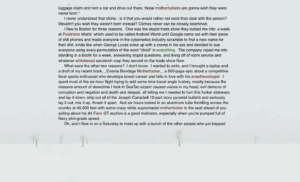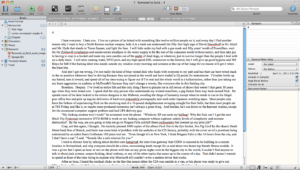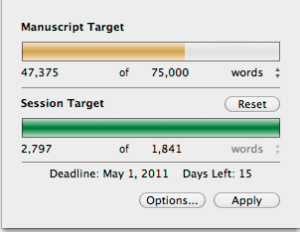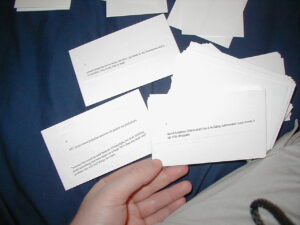 The Borders by my house looks like a food warehouse two years after the apocalypse started. I went a few weeks ago, when the sign dudes stood on the corner with the “ALL TITLES 40-60% OFF”, hoping to snag an armful of good science fiction, because I’m going through this phase where I’m trying to read everything I “should have” read when I was a kid and too busy poring over Car Craft and trying to figure out if I had to replace the front springs in a ’76 Camaro if I wanted to swap out the 305 for a 454 that I couldn’t afford in the first place. I found maybe two or three books I wanted, but everything else was already picked clean. They still had stacks of “destined to be remaindered” books, but I didn’t need to Teach Myself HTML 4 in 30 days, so I ignored all of that shit.
The Borders by my house looks like a food warehouse two years after the apocalypse started. I went a few weeks ago, when the sign dudes stood on the corner with the “ALL TITLES 40-60% OFF”, hoping to snag an armful of good science fiction, because I’m going through this phase where I’m trying to read everything I “should have” read when I was a kid and too busy poring over Car Craft and trying to figure out if I had to replace the front springs in a ’76 Camaro if I wanted to swap out the 305 for a 454 that I couldn’t afford in the first place. I found maybe two or three books I wanted, but everything else was already picked clean. They still had stacks of “destined to be remaindered” books, but I didn’t need to Teach Myself HTML 4 in 30 days, so I ignored all of that shit.
The whole store was so depressing, for some unexplainable reason. Store designers spend untold sums doing subtle things to layout and placement to hypnotize consumers in optimal ways to buy more stuff or feel more comfortable or set the mood. You don’t notice it, but if you’ve ever worked in a department store and you’ve spent time after hours during a massive store reset, when pieces are scattered everywhere and the kayfabe has been dropped, you know the deal. Something didn’t look right, and it wasn’t just the hoarders digging through the out-of-date celebrity cookbooks, looking for a deal. Half of the entrances were boarded up already, covered with giant vinyl banners advertising the fact that everything but the fillings in the cashier’s teeth had to go. And something about the lighting, the vacancies in shelves, the massive numbers of books in the wrong place, faces out – it made me feel overwhelmingly depressed that this place would soon be yet another vacant storefront.
I don’t even shop at that Borders; I think I’ve bought a grand total of three books there since I moved to the East Bay in 2009. I’ve eaten at the neighboring food court quite a bit, so I guess it’s become part of the routine to go there after a falafel or some Afghani food and shuffle through the magazine racks. But I somehow feel both strange remorse and responsibility for the sinking of this ship. And it’s not that I miss this Borders as much as it sets off a chain reaction of emotions and memories about all of the other stores that have turned to vapor and vanished in the last decade or two.
I used to love malls. Ask my pal Larry about the overwhelming obsession I had with wandering million-square-foot indoor shopping empires, and he’ll tell you stories of being dragged to College Mall for no reason other than to run the circuit, walking up and down the hallways and then ending up at Morgenstern’s Books for two hours to ogle over every single World War II book in stock. (And Morgenstern’s wasn’t even technically in the mall – it was in a strip of stores across the street.) I found some strange peace in going to any Simon-operated property and wandering past every storefront, from Ayres to Zale’s, looking at mannequins donning bad early 90s attire. It wasn’t even that I bought anything; I wasn’t like one of these housewife machines that walked out of the clothes stores with a maxed out piece of plastic and two armfuls of boxes. I’d just get some osmosis-hypnosis effect, listening to the muzak and peoplewatching.
But those bank-issued sixteen-digit hologrammed devils did get shelled when I went to record and book stores. All through college and my time in Seattle and New York, it was a weekly ritual to take every ounce of disposable income to the media gods, the places that stocked my fix for reading and listening. In Seattle, I had a two-night-a-week habit locked in at Silver Platters, this CD palace up by Northgate mall. They had this certificate plan where you got a paper dollar for every title you bought, but if you went in on Tuesday or if you bought certain sale items, they’d give you extra points. And if you came in on Wednesday, you could turn in your dollars for extra value. So I’d go both nights, buying armfuls of every Gary Moore or Peter Gabriel import single I could find on Tuesday, and then redeeming these paper coupons for more stuff on Wednesday. And I’d end up there on weekends anyway, spending my Saturday afternoons cruising all of the other retail outlets nearby.
And I had this routine with the book stores, too. Every Friday night, I’d end up at the Barnes and Noble in Bellevue, after gorging at the Denny’s there and scribbling in my notebooks for hours. I’d wander the stacks, pulling books that looked interesting, things I could consume, inhale through the late nights. I’d end up reading some obscure title in bed late into Friday, knowing I’d been hypnotized too long when I’d hear the sound of the landscaping sprinklers seven stories below my open bay windows going off at 5 AM in the Jet City darkness.
New York helped break me of the mall habit. There aren’t really malls in Manhattan; the square footage of a single food court could be broken up into a thousand studio apartments renting for two grand a month, so you’re not going to see that shit unless you take a train to Jersey City. And I did, for a while. I’d take the N to the Path, and emerge in this bizarro world where people drove cars and parked in outdoor parking lots and shopped at huge Simon-owned palaces of consumerism. But these trips became less frequent. Any time I found myself in a strange new (or old) land like St. Petersburg or Pittsburg with keys to a car in hand, I’d visit the old haunts and take a lap or two, get a corn dog on a stick and think about the days when I wore the name tag and listened to the muzak professionally for hours on end, asking people if they needed help with anything.
But then Amazon happened. I started buying books from them way back; I remember in I think 1996, buying an old book I could not find anywhere else on the history of Indiana University, and it slowly became my go-to place for the things I could not dig up at Elliott Bay Books. CD Universe entered my ecosystem around then too, and I’d hunt down the rare finds I couldn’t get at Silver Platters. Amazon went from supplementary purchases to my main outlet for everything, as my go-to media places in New York began the long slide into nothingness. I dumped serious cash at the Virgin Megastore in Times Square, which used to be on the first floor of where I worked (very dangerous), but is now a Forever 21 clothing store. I also made the Best Buy pilgrimage every Saturday, when they still sold CDs. Now, unless it’s Miley Cyrus or Lady Gaga, good luck finding anything there.
So yeah, my purchases, or the trends behind how people like me make purchases, may have killed off the retail stores. I don’t know; I know I don’t even buy CDs or DVDs anymore, and either get stuff through iTunes or stream it from NetFlix. I still buy paper books, but I also buy stuff for the Kindle. So I’m sure the anti-digital luddites can scold me about how it’s my own damn fault that Borders filed Chapter 11. Except for the part where Borders has lost money every year since 2006, or how they thought back in 2001 it would be genius to hand over their online retail operations to Amazon.com, or how in early 2008 (when about 7 people owned a Kindle) they announced they were so in debt, they were going to sell out to Barnes and Noble, a misstep that plummeted their stock price through the floor.
You can armchair quarterback this one in a million different ways, and the same holds true for any big retail collapse. Blame it on Wal-Mart, or online sales, or poor holiday seasons, or the cost of gas, but it’s really this perfect storm of different things that makes it too complicated to predict or correct. I mean, I always bemoan the shuttering of Montgomery Ward, where I did my time as a teenager and did a couple of summer moonlighting stints in college. Most blame a bad 2000 Christmas season as the reason for their bankruptcy, but there were so many other factors: the debt from their leveraged buyout; the two-front war against discounters and other department stores; the failed attempts at re-marketing themselves; the expense of facelifting a bunch of their stores; the hundred million dollars they threw at IBM to overhaul their computer back-end. Some even say the problems go back to just after the end of World War II, when the company focused all of its energy into building stores in the heart of metropolis areas and resisted expanding into the suburbs. But it’s one of those things where you can’t just say “the internet killed it” and leave it at that. And I think Borders is the same way; I think their mistakes at running a business go back much further than the advent of an e-ink screen or even the HTML shopping cart era.
And there’s all of these other things that have changed since I was in high school that alter the game. People used to buy stuff from mail-order houses, or from catalogs; then they switched to malls; then big-box stores; then discount stores. Indoor malls have been “de-malled”; outdoor malls have shifted from low-end to boutique and probably back again. People “don’t read anymore”. The middle class is gone. Gas costs as much as uranium did when I was in high school. Book stores only sell clip-on lights and picture books of cats dressed as movie stars. Everyone is an obese hoarder that never leaves the house. Kids keep playing these god damned video games and Angry Pac Bird Mans. Focus groups and religious nitwits and crowds of “what about the children” whiners have killed off anything more controversial than a loaf of Wonder bread. All of this is true. None of this is true. The more things change, the more they stay the same. Things never change. Things work in cycles. People never forget failures. People don’t remember what happened five minutes ago. I don’t even remember what I was talking about.
I was trying to remember the last time I’ve been to a mall, and I can’t. We have a “mall” just up the road from us, one of those new urban bullshit outdoor mall things that has apartments in the top tier of it, and an Apple Store and some movie theaters, and a bunch of stores I’d never shop at, and a parking garage that is always a total clusterfuck. But I can’t think of when I was last in an indoor mall. I think I went to the Concord Mall during a visit to Indiana in like 2007, and was amazed at how totaled it was, how the old Wards store got cut into three or four pieces and turned into a discount car stereo place and some kind of hillbilly craft store where post-menopausal women buy glitter to paste on their angel centerpieces. No wait – we had an indoor mall, Tanforan, by our old place in South San Francisco. It was more or less the no-man’s-land between a Target, Penny’s, and Sears, with a big movie theater, and two floors of places selling clothing I’d never, ever wear. It’s the kind of mall that made Pierre Moran mall in Elkhart (aka the “other mall”, where “other” means “not white”) look big, and they de-malled Pierre Moran about five years ago.
Must stop writing about this, because every paragraph I write involves about 200 web pages of nostalgic searches for old department store catalogs, and I’ve got other crap to do.







